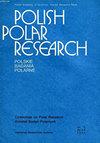Anatomy of the generative structures of the Subantarctic flowering plant Colobanthus apetalus (Labill.) Druce
IF 0.8
4区 地球科学
Q4 ECOLOGY
引用次数: 0
Abstract
: This study investigated the details of the morphological and anatomical structure of the generative organs of the Subantarctic flowering plant, belonging to the family Caryophyllaceae - Colobanthus apetalus (Labill.) Druce. The research material was collected in hostile natural conditions in Subantarctic regions, and also was grown in the incubators and the greenhouse of the University of Warmia and Mazury in Olsztyn (Poland). C . apetalus forms tufts with soft and grassy leaves and small greenish flowers that are more obvious than in other Colobanthus species. C . apetalus forms open (chasmogamic) flowers in greenhouse cultivation. The flowers most often form five stamens with two microsporangia. Over a dozen pollen grains are formed in each microsporangium. Studies of the plant material originated from natural conditions conducted by means of a light microscope, have shown that the ovules of the analyzed representative of the genus Colobanthus are anatropous, crassinucellar, and the monosporic embryo sac develops according to the Polygonum type (the most common type in angiosperms). C . apetalus plants underwent a full development cycle in greenhouse cultivation and produced fertile, perispermic seeds. During the C . apetalus growth in conditions at increased air humidity, the vivipary was also observed.亚南极开花植物无瓣耧菜生殖结构的解剖Druce
本文章由计算机程序翻译,如有差异,请以英文原文为准。
求助全文
约1分钟内获得全文
求助全文
来源期刊

Polish Polar Research
ECOLOGY-GEOSCIENCES, MULTIDISCIPLINARY
CiteScore
2.00
自引率
7.70%
发文量
0
审稿时长
>12 weeks
期刊介绍:
The quarterly Polish Polar Research edited by the Committee on Polar Research of the Polish Academy of Sciences is an international journal publishing original research articles presenting the results of studies carried out in polar regions.
All papers are peer-reviewed and published in English.
The Editorial Advisory Board includes renowned scientist from Poland and from abroad.
 求助内容:
求助内容: 应助结果提醒方式:
应助结果提醒方式:


